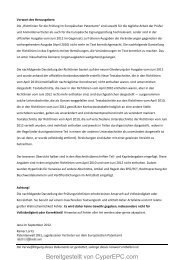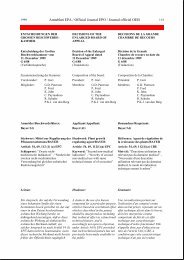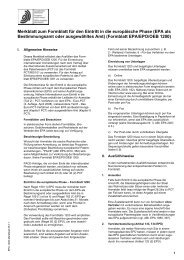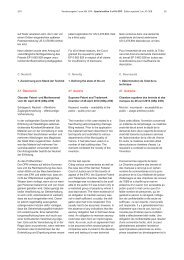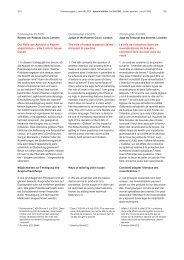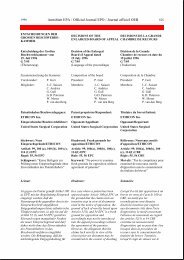Sonderausgabe 3 zum ABl. EPA 2011/107 - CyberEPC
Sonderausgabe 3 zum ABl. EPA 2011/107 - CyberEPC
Sonderausgabe 3 zum ABl. EPA 2011/107 - CyberEPC
Create successful ePaper yourself
Turn your PDF publications into a flip-book with our unique Google optimized e-Paper software.
116 <strong>Sonderausgabe</strong> 3 <strong>zum</strong> <strong>ABl</strong>. <strong>EPA</strong> Special edition 3 of OJ EPO Edition spéciale 3 du JO OEB <strong>2011</strong>hin als Offshore-Pipeline-Ingenieurbezeichnet. Die diesem Fachmanngestellte Aufgabe besteht darin, die Wärmeleistungder existierenden Pipelinesunter im Übrigen gleichen Bedingungenzu verbessern. Nichts im Stand derTechnik führte zu den Merkmalen derErfindung hin. Mikroporöse Erzeugnissegab es nämlich schon seit Anfang der1960er-Jahre, und sie waren vor derErfindung nicht in Pipelines verwendetworden.Laut dem Unternehmen I entspringe dieGedankenführung des Unternehmens Teiner unzulässigen rückschauendenBetrachtungsweise.Zur Definition des Fachmanns führte dasGericht aus, dass feststeht, dass dieserBegriff einen Mann der Praxis umfasst,der darüber unterrichtet ist, was am Tagder Einreichung der betreffenden Patentanmeldung<strong>zum</strong> allgemein üblichenWissensstand auf dem betreffendenGebiet gehört.Aufgrund der Angaben in der Beschreibungder Erfindung ist das zu betrachtendeeinschlägige Fachgebiet nachAuffassung des Gerichts dasjenige derPlanung und des Baus von Rohren mitdoppelter Ummantelung zur Bildungvon Leitungen, die für den Transport vonFlüssigkeiten bei gleichbleibender Temperaturbestimmt sind und bei derenVerlegung besondere Anforderungen zuerfüllen sind (z. B. auf dem Meeresboden).Zwar wird das Gebiet der Erfindungdurch den Wortlaut von Anspruch 1 tatsächlichnicht auf Leitungen für Mineralölerzeugnissebeschränkt, doch geht esin der gesamten Beschreibung um Leitungen,die sowohl hinsichtlich der transportiertenFlüssigkeiten als auch dergeographischen Lage ihrer Verlegungund Länge (mehrere Kilometer) besondereAnforderungen stellen. Im Gegensatz<strong>zum</strong> Unternehmen T war dasGericht der Auffassung, dass der Fachmannnicht ein "Fachmann für die Isolierungvon Leitungen", sondern ein mit derPlanung und dem Bau von Pipelinesbefasster Ingenieur ist.Wie das Unternehmen I zutreffendanmerkt, steht die vom Unternehmen Tvertretene Definition des Fachmanns imWiderspruch zu der Qualifikation derZeugen, die es im schottischen Verfahrenhinzugezogen hat, die alle überline engineer". The problem facing thisexpert was to improve the thermalperformance of existing pipelines underthe usual constraints. There was nothingin the prior art that would lead him to thefeatures of the invention. Microporousproducts had existed since the early1960s and had not been used in pipelinesprior to the invention.For company I, company T's reasoningwas based upon an ex post factoapproach which could not be followed.On the definition of the skilled person,the Court held it to be common groundthat the person skilled in the art was anordinary practitioner possessing generalknowledge of the field at the date of filingof the relevant patent application.In the light of the elements featuring inthe description, the Court considered thefield in question to be the design andmanufacture of pipes with a doublecasing for assembly into pipelines for theconveyance of fluids that had to be keptat a constant temperature and subjectto specific installation constraints (forexample on the ocean bed). Though thewording of claim 1 did not actually limitthe field of the invention to pipelines foroil products, the fact remained that thewhole description related to pipelinessubject to major constraints in terms offluids conveyed, geographical locationand length (several kilometres). Also,contrary to the position of company T,the Court considered the skilled personto be an engineer specialising in pipelinedesign and manufacture, not a "pipelineinsulation technician".According to the Court, company I hadrightly pointed out that company T'sdefinition of the skilled person conflictedwith the type of witnesses it had reliedon within the framework of the Scottishproceedings, who had all had extensivenom d'ingénieur pipeline offshore. Leproblème posé à ce spécialiste estd'améliorer la performance thermiquedes pipelines existants, les contraintesétant égales par ailleurs. Or, rien dansl'art antérieur ne le conduisait aux caractéristiquesde l'invention. En effet, lesproduits microporeux existaient depuisle début des années 1960 et n'ont pasété utilisés dans les pipelines avantl'invention.Pour la société I, le raisonnement de lasociété T est un raisonnement a posterioriqui ne peut pas être suivi.Sur la définition de l'homme du métier,le Tribunal juge qu'il est constant quel'homme du métier s'entend d'un praticiennormalement qualifié qui possèdedes connaissances générales dans ledomaine concerné à la date du dépôt dela demande de brevet concernée.Au vu des éléments figurant dans ladescription de l'invention, le Tribunalestime que le domaine considéré estcelui de la conception et de la fabricationde tuyaux à double enveloppe pourconstituer des canalisations destinées àvéhiculer des fluides devant rester à destempératures constantes et soumisesà des contraintes de pose particulières(par exemple au fond des mers). Sieffectivement le texte de la revendication1 ne limite pas le domaine del'invention aux canalisations de produitspétroliers, il n'en demeure pas moinsqu'il s'agit dans l'ensemble de la description,de canalisations soumises à descontraintes fortes tant en termes defluides véhiculés que de lieux géographiquesde pose et de longueur (plusieurskilomètres). Aussi, contrairement à laposition de la société T, le Tribunal considèreque l'homme du métier n'est pas"le technicien de l'isolation des canalisations",mais un ingénieur en conceptionet fabrication de pipeline.Toujours selon le Tribunal, comme lerelève justement la société I, la définitionde l'homme du métier soutenue par lasociété T est contradictoire avec laqualité des témoins qu'elle a fait intervenirdans le cadre de la procédure



